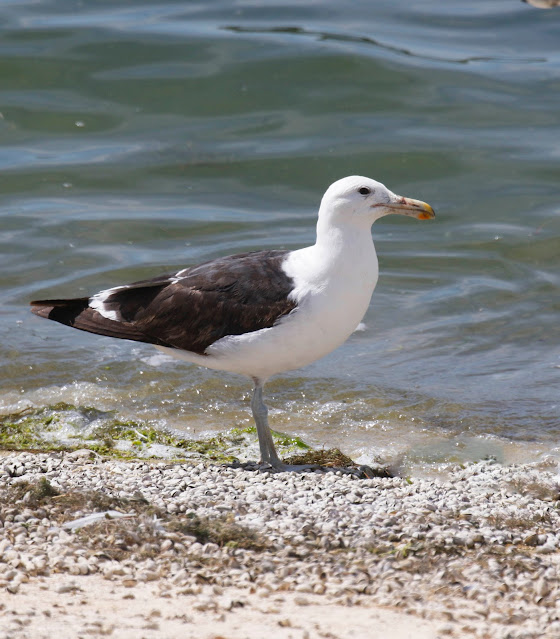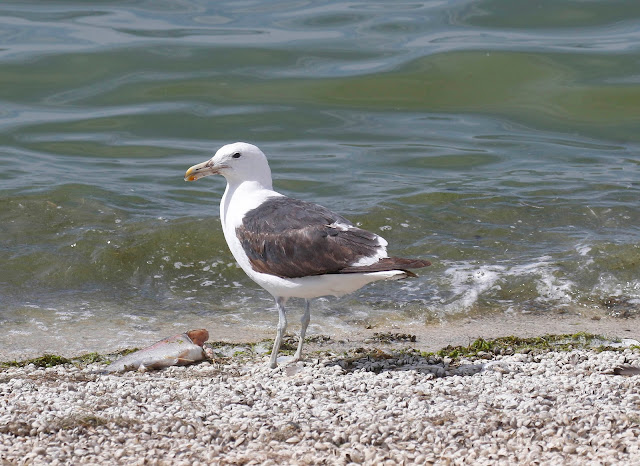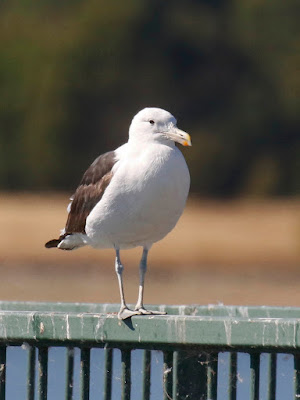The drought and sunshine continues and this morning, with little wind, it was warm and welcoming. The reservoir was flat calm, a tranquil mirror of blue with grebes and coots slicing arrowheads through the still water.
A couple of juvenile Common Terns were noisily fishing close to the causeway and with nothing better to do I occupied my time trying, with partial success, to capture their delicate and graceful movements as they dipped to the water to seize tiny fish from just below the surface.
Fair enough and I retired to the cafe for my customary coffee
I sat at a table and my phone rang. It was Mark my twitching pal
You going for the gull?
What gull?
A probable Kelp Gull. It's a first for Britain if it is one.
Assuming this would entail a nightmarish journey to some far flung island off the coast of Scotland I was pleasantly surprised to learn from Mark it was comparatively close by at Grafham Water, a vast reservoir in Cambridgeshire owned by Anglian Water
Come to mine and we can go together.
Mark put the phone down
I drank my coffee and rang back
Is it certain it is one?
No but if we don't go and it is one we will regret it.
True.This is a familiar dilemna of twitching. Sometimes if it's not certain the information is correct and you dither and do not immediately react, all can be lost.
By now I can drive the route to Mark's home in Bedfordshire in my sleep and having resolved to accept the risk, set off into an uncertain but sunny future.
An hour later I met Mark at the end of his road and we headed for Grafham Water which lies about forty five minutes drive north of Mark's home.
Martin, another of our twitching colleagues lives very near to Grafham and already had the gull under observation and promised to remain with it until we arrived. He gave us regular updates as we drove and told us confidently the gull was going nowhere and looked settled.
Nonetheless stranger things have come to pass and a bird that looks entirely at home and settled can suddenly fly off for no apparent reason and never be seen again. Such anxiety can distort the mind and consequently we were a combination of nervousness and high excitment as we drew into the car park at Grafham on a very warm and sunny Sunday afternoon.Not unsurprisingly the huge car park was almost full and people were enjoying barbecues, picnics and sunbathing on the grassy surrounds of Grafham Water. Add to the mix the huge number of twitchers that were now guaranteed to arrive and it was certainly going to become ever more busy.
An altercation ensued in the car park as we set off to meet Martin and proved an unpleasant diversion.A birder's car had slightly collided with another car that contained possibly two of the most unpleasant foulmouthed people (husband and wife) you could ever have the misfortune to encounter. It was nothing to do with us but a distressed lady standing nearby asked us to go to the aid of the unfortunate birder as she feared the couple were going to resort to violence. After making sure the birder was safe we left as there was no reasoning with the obnoxious pair but later we learnt it was all sorted out without coming to blows.
Come on Mark let's go see the gull
We made our way to a tarmaced walkway/cycle path that runs around the reservoir and joined well over a hundred and fifty others looking over the retaining wall and down onto an area of sun dried mud and stones by the water and with not a tomato in sight.
In amongst the inevitable scattering of Mallards, Canada and Greylag Geese was the Kelp Gull. Superficially similar to a Great Black backed Gull but slightly smaller, it was not hard to locate as it squatted by the water, gasping in the heat and in the company of a few Yellow legged Gulls. Sadly the position of the sun made it nigh on impossible to obtain a decent image.
This popular reservoir, harbouring such an ultra rare gull, was something of a novelty, as a first for Britain is more often to be found on some remote coastline or island requiring a hellish journey, complicated travel arrangements and all the stress that accompanies such a venture but here we were looking over a wall with plenty of room at a gull no more than a short distance from us in what was, I learnt later, a country park.
Kelp Gull comprises of five sub species which belong to one of two groups:
'Dominican Gull' L.d.dominicanus which is found in coastal South America. the Falkland Islands South Georgia, Australia and New Zealand; L.d austrinus of Antarctica and the Antarctic Islands and L d.judithae of subantarctic Indian Ocean islands.
'Cape Gull' L d.vetula which is found in coastal west and southern Africa and L.d.melisandae of coastal south Madagascar
It is not unreasonable to presume this gull at Grafham is a Cape Gull. In fact Cape Gull has been expanding its range from coastal southern Africa and spreading northwards along the west coast of Africa since the 1980's. There was a long staying individual in Mauritania from 1997-2007 and Cape Gulls are now breeding there in small numbers with for example up to six pairs breeding in May 2019. Another was seen in coastal Morocco in 2006, followed by four in 2008. Then one was found in Portugal in 2009 with three separate adults located during 2013, further records following in 2017, 2018, 2019 and 2021. A sub adult was recorded in northern Spain in April 2014. Finally three have been found as near to Britain as northern France, one in and another close to Paris, the first of these was as far back as January 1995 when an adult was discovered with Yellow legged Gulls at Paris Zoo and was the first record of this species in the Western Palearctic, let alone France. The second was at a landfill in February/March 2018 and a third was seen in July 2022.
Although the identity of the bird at Grafham Water was only confirmed today, it was photographed on August 1st but no one noticed that it was anything other than a Great Black backed Gull until someone looked more closely at the photos. The chances of there being others occurring in Britain, especially with the annual late summer influxes of Yellow legged Gulls may not be quite so unlikely as previously thought.
I have seen Dominican Gulls on the Caribbean coast in Colombia and Cape Gulls near, surprise surprise, Cape Town in South Africa. I could not but help thinking that this individual here at Grafham would be feeling entirely at home in all this heat and sunshine.
To my eyes it looked small for a Great Black backed Gull, appearing not that much larger than the Yellow legged Gulls nearby. It was moulting and currently in not quite adult plumage, being in its third year of life. Its upperparts were a combination of old, brownish first generation and new second generation black feathers.The flight feathers were also a combination of old and new, the three inner primaries already moulted and new, the fourth dropped and ready to be replaced while the remainder were old first generation feathers, currently unmoulted and giving the wings a curious uneven, distorted shape when they were spread. The secondaries had yet to begin their moult. Its bill was massive, a blob ended destructive instrument with a prominent gonys and equally noticeable, due to the exaggerated length of the tibia, were the length of its greenish grey legs.
Those of us having seen the bird, relaxed and lapsed into casual conversations, some quite inane, usually involving camera settings and equipment whilst other new arrivals asked anxiously for directions to the gull they had yet to see.
It's flying!
The cry went up and everyone ceased their conversation and followed the gull's progress as it flew along the shoreline to beyond an inlet tower about a quarter of a mile away.We followed at a relaxed pace, as having seen the bird our levels of anxiety and concern were almost back to normal. Other birders, having just arrived hurtled past us, anxiety writ large on their faces, not wanting to miss the gull but they had no need to worry as it was obvious it was not going anywhere.
We got to the required spot and annoyingly the gull flew off again.
As is usual in such situations comments followed as to its whereabouts and were meant to be helpful but were precisely the opposite,
There it is high in the sky. It's just below the vapour trails from that passing aeroplane.
Madness
No one else could see it.
Someone else said it had flown off for good and we would not see it again.
Everyone stood around a bit sheepishly.Not sure if it really had gone.
Of course it had not, as it suddenly returned to land on the shoreline very close to us and set about destroying a dead trout. For a good thirty minutes it tucked into the trout, gulping down bits of flesh and skin as it stood over it, dragging the remains of the fish along the shoreline and all the while remaining virtually opposite me.
I could not ask for more and papped away happily with my camera, along with the many others on either side of me
By early afternoon it was uncomfortably hot in the sun but we endured it until the gull finished feeding, flapped its wings a few times and then flew out onto the water to rest awhile before deciding to fly back to where we had first seen it.
During the previous hours we had been joined by our two other regular twitching buddies, Adrian and Les, and we chatted for an hour in the cafe, greeting other perspiring but elated birders we knew as they came and went. Outside there was a constant stream of newly arrived birders rushing by, all intent on seeing the gull above anything else.
We stirred ourselves and returned to the wall, where the gull remained sat on the shore below and now joined by three Little Egrets and two each of Dunlin and Common Sandpiper, before it eventually flew away to where it had fed on the trout. We followed, a ragged battalion of birders, many wearing camo gear others brightly dressed in tee shirts, some with small children others with dogs, the combined value of the optical equipment we carried running to hundreds of thousands of pounds.
Adrian and Les had by now departed so it was just Mark and myself along with a hundred others. We followed the gull to find it had perched on some railings guarding the walkway to the inlet tower.
Slowly the time slipped away, Mark accepted there were no more opportunities to photo the gull and it was really time to go home.
Quite a day.






.jpg)
.jpg)


.jpg)






















No comments:
Post a Comment